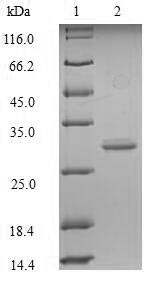This recombinant Mouse Glucagon-like peptide 1 receptor (Glp1r) gets expressed in E. coli and covers amino acid region 22-145. The protein carries an N-terminal 6xHis-SUMO tag, which makes purification and detection more straightforward. SDS-PAGE analysis confirms the purity exceeds 90%. This product is designed strictly for research purposes and appears to offer a dependable tool for studies that need high-quality protein standards.
The Glucagon-like peptide 1 receptor (GLP1R) seems to play a central role in glucose metabolism and insulin signaling. It acts as a key player in blood sugar regulation and participates in pathways that may influence both appetite and insulin secretion. Researchers studying metabolic diseases often focus on GLP1R, since it represents an important target for understanding diabetes and related conditions.
Potential Applications
Note: The applications listed below are based on what we know about this protein's biological functions, published research, and experience from experts in the field. However, we haven't fully tested all of these applications ourselves yet. We'd recommend running some preliminary tests first to make sure they work for your specific research goals.
The mouse GLP1R is a GPCR whose extracellular domain requires proper folding and disulfide bond formation for ligand binding. E. coli lacks eukaryotic chaperones and may not support correct disulfide bonding in the reducing cytoplasm. The large SUMO tag (≈100 aa) may sterically hinder the receptor's ligand-binding pocket. Without experimental validation (e.g., GLP-1 binding assays), the protein cannot be assumed to be correctly folded or bioactive. The high purity indicates low impurities, but does not guarantee native conformation.
1. Antibody Development and Validation
This application is suitable. The recombinant GLP1R fragment can serve as an immunogen for generating antibodies against linear epitopes. The high purity supports consistent immunization. However, antibodies may not recognize conformational epitopes of native, properly folded GLP1R. Validate antibody specificity against full-length GLP1R expressed in mammalian cells.
2. Protein-Protein Interaction Studies
Use with caution. The His-SUMO tag enables pull-down assays, but if the extracellular domain is misfolded, interactions may be non-physiological. The tag itself may cause artifactual binding. Validate any identified interactions (especially with GLP-1) using full-length GLP1R from eukaryotic systems.
3. Biochemical Characterization and Stability Studies
Suitable for basic biophysical analysis (e.g., circular dichroism for secondary structure). However, data may not reflect native GLP1R properties due to potential misfolding and the large SUMO tag. Use the protein for stability studies, but interpret results in the context of the recombinant fragment.
4. ELISA-Based Binding Assays
Not recommended without binding validation. If the extracellular domain is misfolded, it will not accurately measure GLP-1 binding. First, confirm ligand-binding capability via SPR or competitive ELISA before developing quantitative assays.
Final Recommendation & Action Plan
Before using this recombinant GLP1R fragment for functional applications, validate its folding and ligand-binding capability. Perform a GLP-1 binding assay using surface plasmon resonance (SPR) or competitive ELISA. If active, proceed with interaction studies; if inactive, limit use to antibody production (with validation against native GLP1R). For reliable results, express the extracellular domain in mammalian cells with proper folding machinery. Always include full-length GLP1R controls when studying receptor function.






